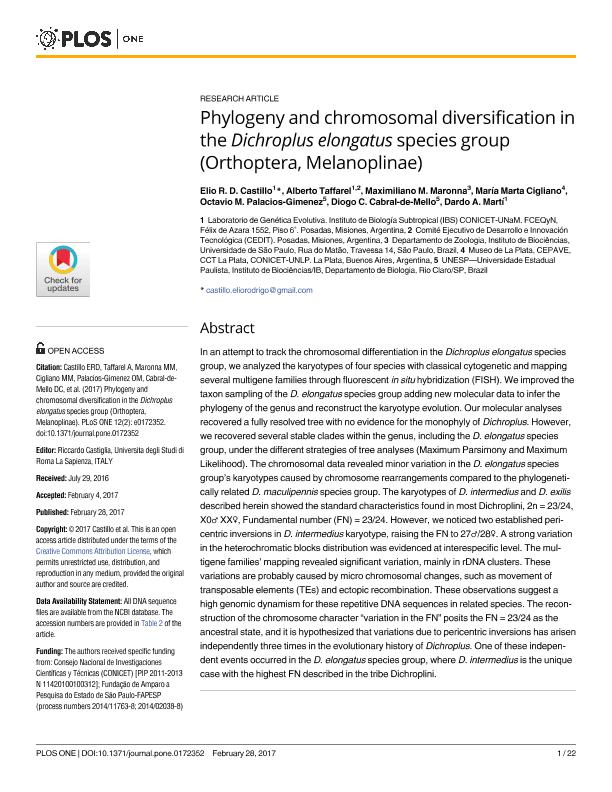Mostrar el registro sencillo del ítem
dc.contributor.author
Castillo, Elio Rodrigo Daniel

dc.contributor.author
Taffarel, Alberto

dc.contributor.author
Maronna, Maximiliano M.
dc.contributor.author
Cigliano, Maria Marta

dc.contributor.author
Palacios Gimenez, Octavio Manuel
dc.contributor.author
Cabral de Mello, Diogo C.
dc.contributor.author
Marti, Dardo Andrea

dc.date.available
2018-10-26T14:43:46Z
dc.date.issued
2017-02
dc.identifier.citation
Castillo, Elio Rodrigo Daniel; Taffarel, Alberto; Maronna, Maximiliano M.; Cigliano, Maria Marta; Palacios Gimenez, Octavio Manuel; et al.; Phylogeny and chromosomal diversification in the Dichroplus elongatus species group (Orthoptera, Melanoplinae); Public Library of Science; Plos One; 12; 2; 2-2017; 1-22
dc.identifier.uri
http://hdl.handle.net/11336/63133
dc.description.abstract
In an attempt to track the chromosomal differentiation in the Dichroplus elongatus species group, we analyzed the karyotypes of four species with classical cytogenetic and mapping several multigene families through fluorescent in situ hybridization (FISH). We improved the taxon sampling of the D. elongatus species group adding new molecular data to infer the phylogeny of the genus and reconstruct the karyotype evolution. Our molecular analyses recovered a fully resolved tree with no evidence for the monophyly of Dichroplus. However, we recovered several stable clades within the genus, including the D. elongatus species group, under the different strategies of tree analyses (Maximum Parsimony and Maximum Likelihood). The chromosomal data revealed minor variation in the D. elongatus species group's karyotypes caused by chromosome rearrangements compared to the phylogenetically related D. maculipennis species group. The karyotypes of D. intermedius and D. exilis described herein showed the standard characteristics found in most Dichroplini, 2n = 23/24, X0♂ XX♀, Fundamental number (FN) = 23/24. However, we noticed two established pericentric inversions in D. intermedius karyotype, raising the FN to 27♂/28♀. A strong variation in the heterochromatic blocks distribution was evidenced at interespecific level. The multigene families' mapping revealed significant variation, mainly in rDNA clusters. These variations are probably caused by micro chromosomal changes, such as movement of transposable elements (TEs) and ectopic recombination. These observations suggest a high genomic dynamism for these repetitive DNA sequences in related species. The reconstruction of the chromosome character "variation in the FN" posits the FN = 23/24 as the ancestral state, and it is hypothesized that variations due to pericentric inversions has arisen independently three times in the evolutionary history of Dichroplus. One of these independent events occurred in the D. elongatus species group, where D. intermedius is the unique case with the highest FN described in the tribe Dichroplini.
dc.format
application/pdf
dc.language.iso
eng
dc.publisher
Public Library of Science

dc.rights
info:eu-repo/semantics/openAccess
dc.rights.uri
https://creativecommons.org/licenses/by-sa/2.5/ar/
dc.subject
Dichroplus Elongatus Species Group
dc.subject
Chromosome Evolution
dc.subject
Phylogeny
dc.subject.classification
Otras Ciencias Biológicas

dc.subject.classification
Ciencias Biológicas

dc.subject.classification
CIENCIAS NATURALES Y EXACTAS

dc.title
Phylogeny and chromosomal diversification in the Dichroplus elongatus species group (Orthoptera, Melanoplinae)
dc.type
info:eu-repo/semantics/article
dc.type
info:ar-repo/semantics/artículo
dc.type
info:eu-repo/semantics/publishedVersion
dc.date.updated
2018-10-19T20:41:11Z
dc.identifier.eissn
1932-6203
dc.journal.volume
12
dc.journal.number
2
dc.journal.pagination
1-22
dc.journal.pais
Estados Unidos

dc.journal.ciudad
San Francisco
dc.description.fil
Fil: Castillo, Elio Rodrigo Daniel. Consejo Nacional de Investigaciones Científicas y Técnicas. Centro Científico Tecnológico Conicet - Nordeste. Instituto de Biología Subtropical. Universidad Nacional de Misiones. Instituto de Biología Subtropical; Argentina
dc.description.fil
Fil: Taffarel, Alberto. Consejo Nacional de Investigaciones Científicas y Técnicas. Centro Científico Tecnológico Conicet - Nordeste. Instituto de Biología Subtropical. Universidad Nacional de Misiones. Instituto de Biología Subtropical; Argentina. Provincia de Misiones. Comite de Desarrollo E Innovación Tecnologica; Argentina
dc.description.fil
Fil: Maronna, Maximiliano M.. Universidade de Sao Paulo; Brasil
dc.description.fil
Fil: Cigliano, Maria Marta. Consejo Nacional de Investigaciones Científicas y Técnicas. Centro Científico Tecnológico Conicet - La Plata. Centro de Estudios Parasitológicos y de Vectores. Universidad Nacional de La Plata. Facultad de Ciencias Naturales y Museo. Centro de Estudios Parasitológicos y de Vectores; Argentina
dc.description.fil
Fil: Palacios Gimenez, Octavio Manuel. Universidade Estadual Paulista Julio de Mesquita Filho; Brasil
dc.description.fil
Fil: Cabral de Mello, Diogo C.. Universidade Estadual Paulista Julio de Mesquita Filho; Brasil
dc.description.fil
Fil: Marti, Dardo Andrea. Consejo Nacional de Investigaciones Científicas y Técnicas. Centro Científico Tecnológico Conicet - Nordeste. Instituto de Biología Subtropical. Universidad Nacional de Misiones. Instituto de Biología Subtropical; Argentina
dc.journal.title
Plos One

dc.relation.alternativeid
info:eu-repo/semantics/altIdentifier/url/https://journals.plos.org/plosone/article?id=10.1371/journal.pone.0172352
dc.relation.alternativeid
info:eu-repo/semantics/altIdentifier/doi/http://dx.doi.org/10.1371/journal.pone.0172352
Archivos asociados
